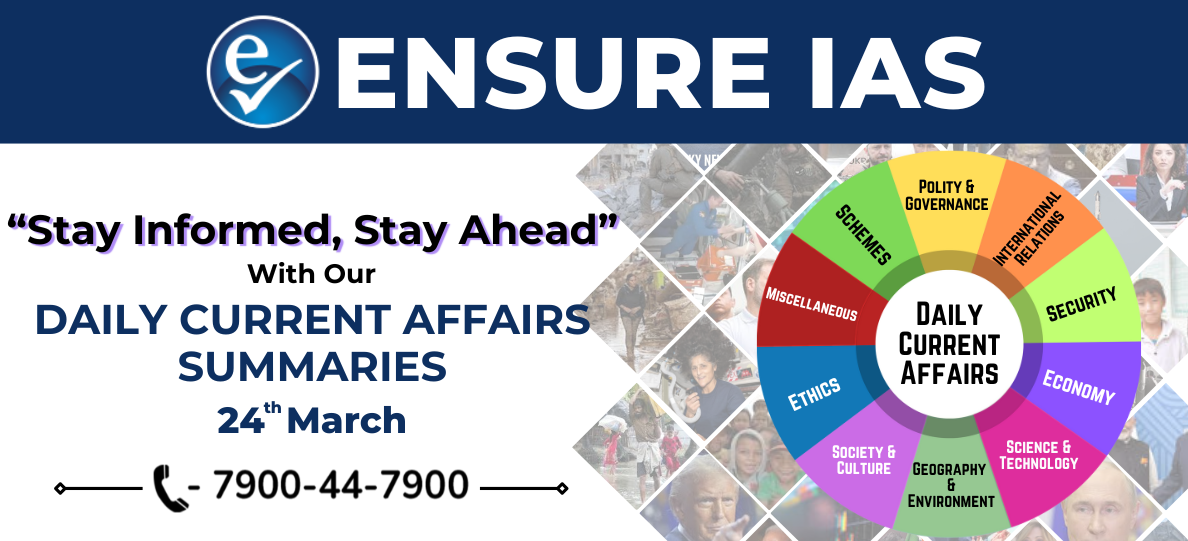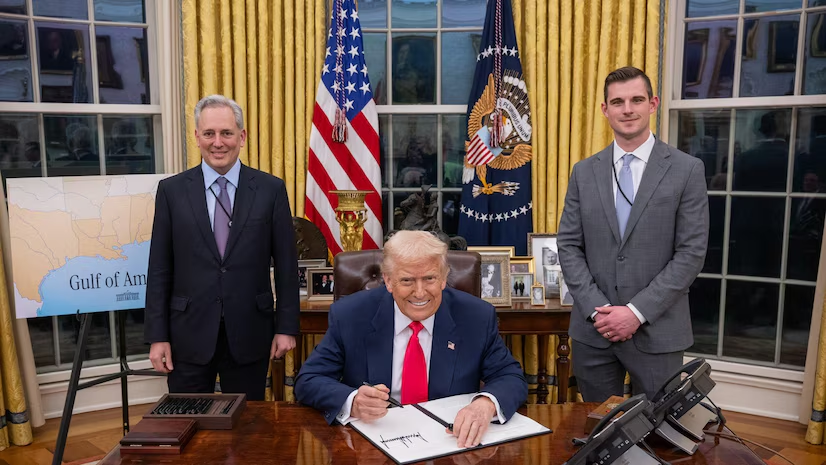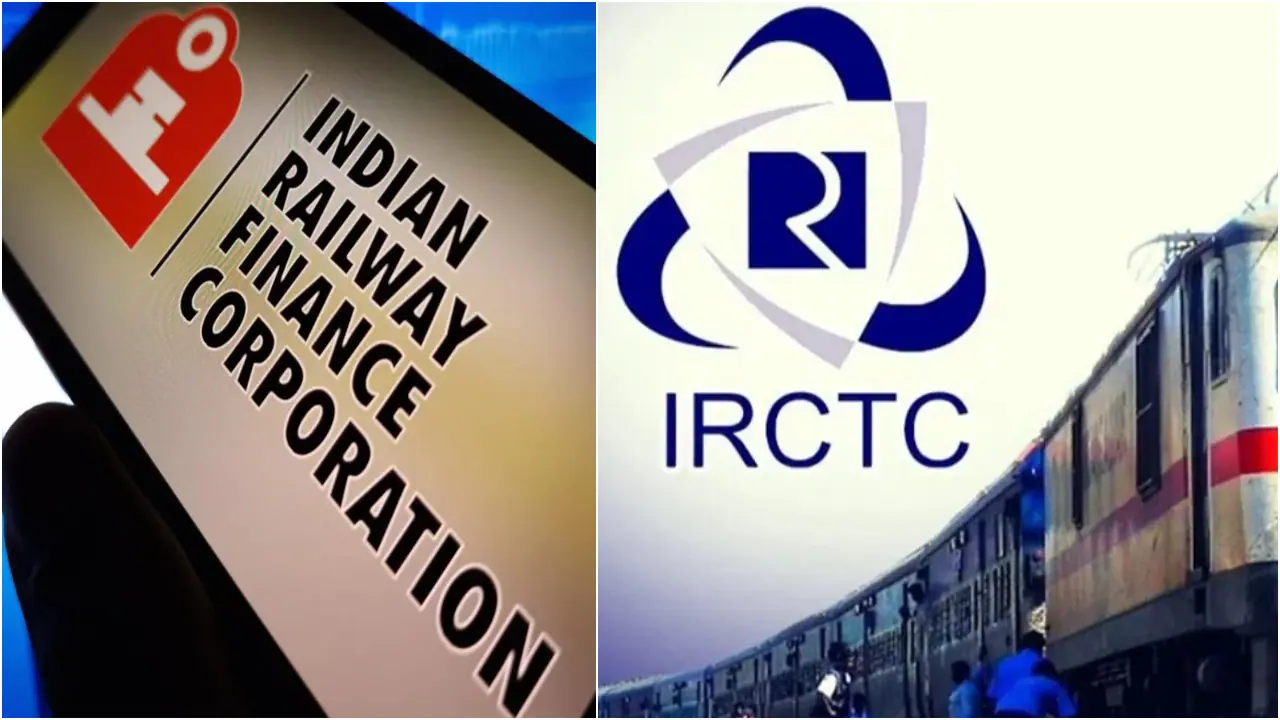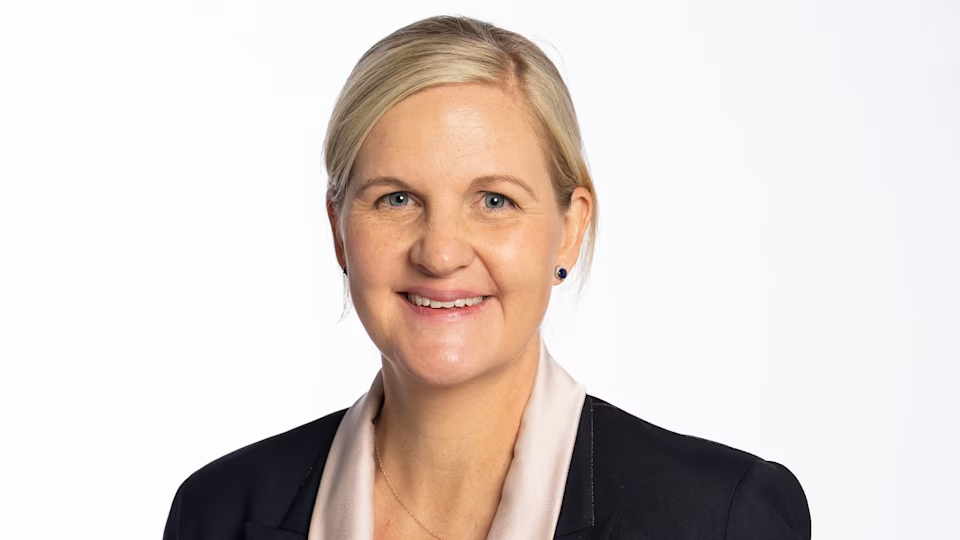- Courses
- GS Full Course 1 Year
- GS Full Course 2 Year
- GS Full Course 3 Year
- GS Full Course Till Selection
- CSAT
- 5 LAYERED ARJUNA Mentorship
- Public Administration Optional
- Online Program
- GS Recorded Course
- NCERT Batch
- Polity Module Course
- Geography Module Course
- Economy Module Course
- AMAC Module Course
- Modern India, Post Independence & World History Module Course
- Environment Module Course
- Governance Module Course
- Science & Tech. Module Course
- International Relations and Internal Security Module Course
- Disaster Management Module Course
- Ethics Module Course
- Essay Module Course
- Current Affairs Module Course
- ABOUT US
- OUR TOPPERS
- TEST SERIES
- FREE STUDY MATERIAL
- VIDEOS
- CONTACT US
Daily Current Affairs Summary - 24th March 2025
Daily Current Affairs Summary - 24th March 2025

Okjökull: The First Glacier to Be Officially Declared Dead Due To Climate Change
- The disappearance of glaciers is no longer a distant threat—it is a reality unfolding before our eyes.
- A poignant example of this global crisis is the Okjökull Glacier in Iceland, which became the first glacier in the world to be officially declared dead due to climate change.
What Happened to Okjökull?
- In 2014, the Okjökull glacier, once a massive ice body on the Ok shield volcano, located northwest of Reykjavík, the capital of Iceland, was declared dead.
- The glacier had become so thin that it ceased to move, which is a defining feature of active glaciers. Without the ability to flow under its own weight, Okjökull lost its status as a glacier.
- This tragic loss marked a symbolic moment in the climate crisis and was memorialized in 2019 with a plaque titled "A Letter to the Future", urging global action against climate change.
Other Vanishing Glaciers Across the Globe
Okjökull is not alone. Several other glaciers have already disappeared or are on the verge of extinction due to rising global temperatures. These include:
- USA: Anderson Glacier, Clark Glacier, Glisan Glacier
- New Zealand: Baumann Glacier
- Italy: Calderone Glacier
- Argentina: Martial Sur Glacier
- Venezuela: Pico Humboldt Glacier
- Switzerland: Pizol Glacier
- France: Sarenne Glacier
- Germany: Schneeferner Glacier
This widespread phenomenon illustrates the alarming global scale of glacial retreat.
Understanding Glaciers: Nature’s Frozen Reservoirs
A glacier is a large, persistent mass of snow and ice that forms over centuries and moves slowly across land under the influence of gravity and its own weight. They are typically found in regions where:
- Temperatures remain near freezing throughout the year.
- Winter snowfall accumulates over time without fully melting in summer.
Why Are Glaciers Important?
- Freshwater Reservoirs: Glaciers store nearly three-quarters of the world’s freshwater, playing a vital role in the hydrological cycle.
- Agricultural Support: Meltwater from glaciers sustains irrigation systems and maintains soil fertility in downstream regions.
- Biodiversity Contributor: As glaciers melt, they release nutrients into water bodies, supporting phytoplankton growth, which forms the base of aquatic food chains.
Melting Glaciers: A Multidimensional Threat
Climate change is accelerating the melting of glaciers worldwide, triggering several environmental and socio-economic consequences:
- Disruption of Water Cycles: Altered stream flows, decreased water availability, and stress on agriculture.
- Increased Natural Disasters: Rising instances of Glacial Lake Outburst Floods (GLOFs) and avalanches, especially in mountainous regions like the Himalayas.
- Rising Sea Levels: Rapid glacial melt contributes to coastal erosion, habitat destruction, and displacement of communities.
- Albedo Feedback Loop: As ice disappears, Earth’s surface reflectivity (albedo) reduces, leading to greater absorption of heat and faster warming—a vicious climate feedback loop.
Global and National Efforts to Preserve Glaciers
Recognizing the urgency of glacier conservation, both global institutions and national governments have initiated focused efforts:
Global Initiatives
- The United Nations has declared 2025 as the International Year of Glaciers’ Preservation, emphasizing global cooperation in glacier protection.
- UNESCO’s Intergovernmental Hydrological Programme (IHP) also supports glacier monitoring and research.
Indian Initiatives
India, home to the Himalayan cryosphere, has launched multiple scientific programs:
- Network Programme on the Himalayan Cryosphere: Coordinates glacier studies across Indian institutions.
- Centre for Cryosphere and Climate Change Studies: Facilitates research on glacial dynamics and climate interactions.
- HIMANSH Research Station: India’s high-altitude research base in the Himalayas, monitoring glacial health and related climate parameters.
Sahyog Portal: Strengthening Cybercrime Control in India
In a significant move to bolster cybercrime regulation and digital law enforcement, both Central and State governments have started using the Sahyog Portal to issue orders for blocking unlawful online content.
What is the Sahyog Portal?
- The Sahyog Portal is a digital platform developed by the Ministry of Home Affairs (MHA) with the primary objective of creating a robust ecosystem for cybercrime prevention and control across the country.
- It is part of India’s broader effort to tackle rising digital offenses through efficient coordination between government agencies and digital service providers.
Key Features and Functions
- Mission and Objective: To establish an effective framework for the prevention, detection, investigation, and prosecution of cybercrimes in India.
- Legal Framework: The portal functions under the provisions of the Information Technology Act, 2000, enabling smooth and structured communication between authorities and online intermediaries.
- Automated Notice System: Sahyog automates the process of sending takedown notices to digital platforms and intermediaries by authorized government agencies, significantly reducing manual workload and response delays.
- Content Regulation: The platform facilitates the blocking or disabling of access to online information, data, or communication links that are used for committing unlawful acts or violating legal norms.
- Integrated Communication Platform: It acts as a centralized interface connecting all Authorized Agencies and digital intermediaries (such as social media platforms, websites, and service providers), ensuring seamless and secure information exchange.
Why is it Important?
With the exponential growth of digital content and online platforms, the need for swift and coordinated action to tackle cyber threats, misinformation, hate speech, and unlawful content has become critical. The Sahyog Portal serves as a crucial tool in this regard by:
- Enhancing transparency and accountability in digital governance.
- Streamlining government action against harmful content.
- Supporting timely enforcement of legal provisions on digital platforms.
Tobacco Production and Export: India’s Growing Footprint
India has witnessed a significant rise in tobacco exports, doubling over the last four years, highlighting the country's expanding role in the global tobacco trade.
India’s Global Standing
- Second largest producer of tobacco after China.
- Second largest exporter globally, next only to Brazil.
Major Producing States
- Gujarat: Accounts for 45% of total cultivated area and nearly 30% of total production.
- Other key states include Andhra Pradesh, Karnataka, Uttar Pradesh, and Bihar.
Favourable Growing Conditions
- Temperature: Optimal range between 20°C to 27°C.
- Rainfall: Ideally around 500 mm, well-distributed during the growing season. Excess rainfall (above 1200 mm) is generally unsuitable.
- Soil Type: Prefers sandy or sandy loam soils. However, Andhra Pradesh’s cigarette-tobacco is an exception where it is cultivated on heavy black soils.
Proof of Origin: New Customs Rules Notified
The Ministry of Finance has notified the Customs (Administration of Rules of Origin under Trade Agreements) Amendment Rules, 2025, modifying the existing 2020 rules under the Customs Act, 1962.
Key Change
- Importers are now required to submit ‘proof of origin’ instead of just a ‘certificate of origin’ to avail preferential duty rates under trade agreements.
- This proof ensures that the goods are entirely obtained, produced, manufactured, or processed in a specific country.
Why It Matters
- Enhanced verification: Customs authorities can now demand additional supporting evidence to validate origin claims.
- Curb misuse: The change aims to tighten scrutiny on imports, especially goods from China routed through ASEAN, Sri Lanka, or UAE to bypass higher tariffs and restrictions.
National Board of Accreditation (NBA) – NIRF Rankings Stay
The Madras High Court has granted an interim stay on the publication of the National Institutional Ranking Framework (NIRF) Rankings for 2025, restraining the National Board of Accreditation (NBA) from releasing the list.
About NIRF
The National Institutional Ranking Framework aims to bring transparency and accountability to the higher education system by providing a standardised method to rank institutions across various parameters like teaching, research, outreach, and perception.
About NBA (National Board of Accreditation)
- Established: In 1994 under Section 10(u) of the AICTE Act, 1987.
- Autonomous Status: Became an autonomous body in 2010.
- Mandate: Responsible for assessing the quality of individual academic programs, not institutions, in fields like Engineering, Technology, Management, Pharmacy, etc.
Ottawa Convention – NATO Nations Plan Withdrawal
Amid rising military tensions with Russia, NATO members Poland, Lithuania, Latvia, and Estonia have announced plans to withdraw from the Ottawa Convention, citing the need for enhanced military preparedness.
What is the Ottawa Convention?
- Official Name: Convention on the Prohibition of the Use, Stockpiling, Production and Transfer of Anti-Personnel Mines and on their Destruction.
- Objective:
- Prohibits the use, development, stockpiling, and transfer of anti-personnel landmines.
- Mandates destruction of existing stockpiles.
- Adoption & Enforcement:
- Adopted in Oslo (1997) and signed at Ottawa.
- Came into force in 1999.
- Signatories: 133 countries (India is not a signatory).
- Depositary Authority: Secretary-General of the United Nations.
Raisina Dialogue 2025 – India’s Global Strategic Conclave
The 10th edition of the Raisina Dialogue was recently held in New Delhi, reinforcing India’s role in shaping global strategic discourse.
Key Highlights:
- Organised by: Observer Research Foundation (ORF) in collaboration with the Ministry of External Affairs, Government of India.
- About the Dialogue: India’s premier annual conference on geopolitics and geo-economics, aimed at addressing critical global challenges through multi-stakeholder discussions.
- Global Participation: Delegates from around 125 countries, including Heads of State, Ministers, Diplomats, Academicians, Think Tanks, and Youth leaders.
- Theme for 2025: “Kālachakra – People, Peace and Planet”, focusing on sustainable and inclusive global progress.
- Key Discussion Tracks: Covered six broad thematic pillars such as Green Trilemma, Digital Planet, and other pressing global issues.
Altermagnetism – A New Era in Magnetic Materials
Researchers in Sweden have discovered a novel form of magnetism known as Altermagnetism, which could revolutionize the future of electronic and memory devices.
What is Altermagnetism?
- Definition: Altermagnetism merges the advantageous properties of both ferromagnets and antiferromagnets, offering a unique magnetic behavior not found in conventional materials.
- Unlike ferromagnets (e.g., iron, nickel) that exhibit aligned electron spins, and antiferromagnets where opposite spins cancel each other out, altermagnets possess a dual nature — they exhibit zero net magnetization like antiferromagnets, yet show non-relativistic spin splitting like ferromagnets.
Potential Applications:
- Faster memory devices with higher data processing speeds.
- Improved efficiency and performance in next-generation electronic systems.
Kirsty Coventry: First female president of International Olympic Committee (IOC)
In a historic development, Zimbabwean former swimmer Kirsty Coventry has become the first female president of the International Olympic Committee (IOC).
About IOC
- The IOC is an independent, not-for-profit organization responsible for overseeing the global Olympic movement.
- Headquarters: Located in Lausanne, Switzerland, also known as the Olympic Capital.
- Established: Founded during the first Olympic Congress in Paris in 1894.
- Vision: "To Build a Better World through Sport."
Key Functions
- Decides which sports are included in the Olympics.
- Selects host cities for future Olympic Games.
- Coordinates with key stakeholders—athletes, National Olympic Committees (NOCs), and international sports federations.
- In India, the Indian Olympic Association (IOA) functions as the country’s NOC.
Funding
The IOC is entirely privately funded, with 90% of its revenue directed towards the development of sports and athletes at all levels.
Unified Logistics Interface Platform (ULIP)
The Unified Logistics Interface Platform (ULIP) has recently marked a significant achievement by crossing 100 crore API transactions, highlighting its growing adoption in India’s logistics ecosystem.
What is ULIP?
- Launched under the National Logistics Policy (2022), ULIP aims to foster an integrated, technology-driven, and efficient logistics sector.
- It serves as a digital gateway that enables stakeholders in the logistics industry to access real-time logistics-related data from various government systems through API-based integration.
Key Highlights
- Conceptualized by: NITI Aayog.
- Managed by: NICDC Logistics Data Services Ltd. (NLDSL).
- NLDSL is a joint venture between the Government of India (through NICDIT) and Japanese IT giant NEC Corporation.
ULIP is transforming logistics management by ensuring data transparency, improved coordination, and operational efficiency across the supply chain.
REDD+
Forest Declaration Assessment Special Report ‘Transforming Forest Finance’ highlighted that REDD+ has not delivered the scale of forest finance needed.
About REDD and REDD+
- REDD+ is a climate change mitigation solution developed by the UNFCCC parties under the Warsaw Framework 2013.
- REDD (Reducing Emissions from Deforestation and Forest Degradation) focuses on reducing deforestation in developing countries.
- REDD+ expands this by including additional forest-related activities like sustainable forest management and enhancing forest carbon stocks.
- Under REDD+, developing countries receive results-based payments for reducing deforestation, incentivizing their climate protection efforts.
Financial Assistance for Promotion of Art and Culture Scheme
The Ministry of Culture implements the Central Sector Scheme – Financial Assistance for Promotion of Art and Culture, aimed at supporting cultural organizations engaged in preserving and promoting India's rich artistic and cultural heritage.
Objective:
To extend financial assistance to eligible cultural bodies across the country working in diverse fields of art and culture.
Key Components of the Scheme:
- Assistance to Cultural Organizations with National Presence
- Cultural Function and Production Grant (CFPG)
- Support for Preservation & Development of Cultural Heritage of the Himalayas
- Assistance to Buddhist/Tibetan Cultural Organizations
- Grants for Building Infrastructure including Studio Theatres
- Support for Allied Cultural Activities
- Promotion of Intangible Cultural Heritage
- Financial Support for Domestic Festivals and Fairs
The scheme plays a pivotal role in fostering cultural vibrancy and diversity, while ensuring that traditional art forms and institutions receive the necessary support for their sustenance and growth.
GPS Spoofing: A Rising Threat to Navigation Security
India has reported 465 incidents of GPS interference and spoofing in its border regions between November 2023 and February 2025, highlighting growing concerns over navigational safety and national security.
What is GPS Spoofing?
GPS spoofing is a deceptive technique that manipulates the Global Positioning System (GPS) signals by transmitting false signals to mislead GPS receivers. This results in the receiver interpreting incorrect location or time data.
How It Works:
- Attackers use signal generators or advanced equipment to emit counterfeit GPS signals that overpower genuine satellite signals.
- These false signals can trick navigational systems into believing the wrong position or timing data.
Why It Matters:
- Modern aviation systems like autopilots, flight computers, and collision-avoidance systems heavily rely on precise GPS inputs.
- Spoofing can disrupt critical satellite-based applications, pose risks to transport safety, and affect military and strategic operations.
World Happiness Report 2025: India Ranks 118th
The World Happiness Report 2025 has been released by the Wellbeing Research Centre at the University of Oxford, in collaboration with Gallup, the UN Sustainable Development Solutions Network, and an independent editorial board.
About the Report
The global happiness ranking is based on responses to a single key question derived from the Cantril Self-Anchoring Striving Scale (also known as the Cantril Ladder).
- Respondents rate their lives on a scale from 0 (worst possible life) to 10 (best possible life).
Key Evaluation Parameters:
- GDP per capita
- Social support
- Healthy life expectancy at birth
- Freedom to make life choices
- Generosity
- Perceptions of corruption
Global Rankings:
- Finland retains the top position, followed by Denmark and Iceland.
- India stands at 118th out of 147 countries, reflecting the need for improvement in overall wellbeing indicators.
|
Also Read |
|
| FREE NIOS Books | |




